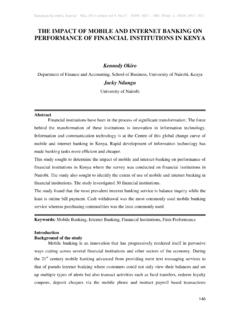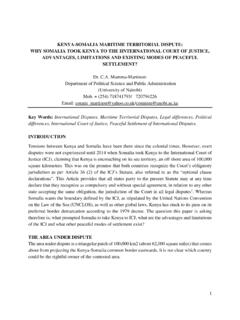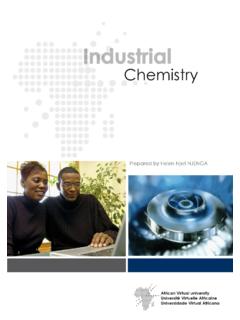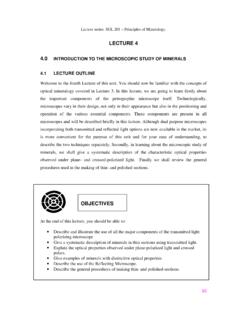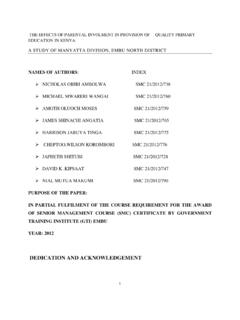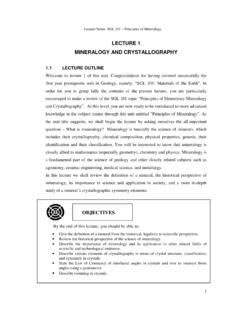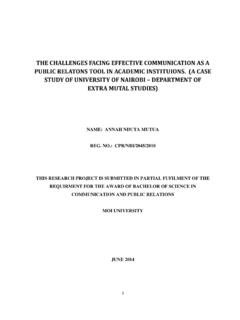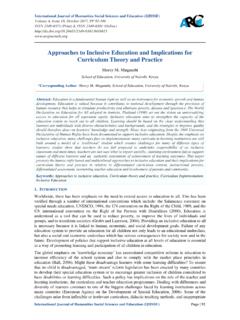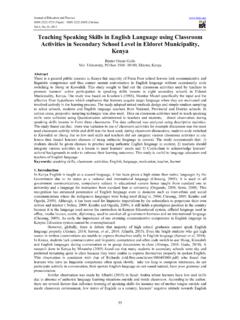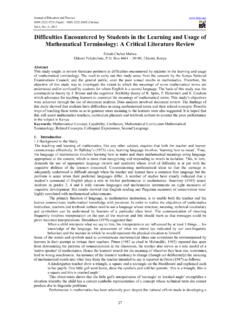Transcription of CHAPTER ONE: INTRODUCTION 1.1 Background of the study
1 CHAPTER ONE: INTRODUCTION . Background of the study In pursuit of better employee performance and customer satisfaction, organizations are looking for and investing in strategies to enhance output. Heterogeneity being a key characteristic of services, service firms are determined to optimize their employees' output in order to ensure that their customers are always contented as a result of consuming quality delivered services (James and Mona, 2011). Service firms are thus implementing Quality Control (QC) in their operations so as to ensure that their employees always perform their tasks right the first time and that their customers' expectations are always met or exceeded after consumption of the firm's products or services. Quality control techniques, their capabilities and limitations should never by themselves dictate the employees' performance. It is by weaving these quality control techniques into the fabric of the employees operations that a company can bring the most value from its employee performance as observed by Aquilano and Chase (1991).
2 A service firm that therefore integrates quality control systems directly into its employees' operations stands the best chance to optimize its employee goals, and thus increase customer satisfaction. Therefore, the best model for better employee performance is to fully integrate all its quality control systems and its employees operations into one set of intimately linked processes. With customers in the service market being not only cautious with the quality of products and services they consume, but also in the manner in which the latter is delivered, and them being also key participants in the delivery system of the service, organizations are forced to implement quality control techniques in their operations in order to assist and ensure that their employees perform their respective tasks the right way the first time. Quality control thus assists and ensures that the employees are able to meet or exceed their customers' expectations of the service or product by delivering the services or products effectively, that is in the quality expected by the customers (Aquilano and Chase, 1991).
3 Quality Control Quality control is a procedure or set of procedures intended to ensure that a manufactured products or performed service adheres to a defined set of quality criteria or meets the -1- requirements of the customer (Oakland, 1986). According to Evans and Lindsay (2002), quality control is a management system for initiating and coordinating quality development, quality maintenance and quality improvement in various departments of design and manufacturing, for achieving the twin objectives of economical production and customer satisfaction. In pursuit of efficiency in operational performance by organizations in terms of reduction of the total cost of quality, organizations recognize the need to implement quality control in their operations especially at the point of manufacture or operation, and not only at the final product or service stage. Organizations have it right to apply cost-effective control techniques to ensure that all goods and services are generated correctly the first time.
4 The logic is not to ask whether the job has been done correctly, instead the prudent question to always ask first is: can we do the job correctly? (Oakland, 1986). With increased competition and consumer awareness of quality, organizations are implementing quality control techniques in their operations to ensure that they perform their operations, production and delivery of their goods or services, correctly the first time. Examples of quality control techniques that can be implemented by organizations to ensure efficiency and effectiveness of its operations in terms of providing products and services that are dependable, satisfactory and economical, ensuring economic production of products and delivery of services of uniform quality acceptable to the customer, and preventing the occurrence of defect products or service, include; Quality at the source, Inspection, Statistical Quality Control (SQC), Quality Circle, and Total Quality Management (TQM) (Barnes, 2008).
5 Employee Performance Effective performance management is designed to enhance performance, identify performance requirements, provide feedback relevant to those requirements and assist with career development (Ainsworth, Smith and Millership, 2008). The idea is that performance management is best served by developing a system that is interactive and capable of resolving performance related issues. Organizations make investments in their human capital to improve performance and target higher niches in the market through delivery of high quality services (Appelbaum, Bailey and Berg, 2000).Employee performance affects the overall performance of an organization and its bottom-line (Purcell and Hutchison 2007). -2- Employee performance is influenced by motivation. Armstrong (2009) points out that motivation is concerned with the strength and direction of behavior and the factors that influence people to behave in certain ways. Buchner (2007) points to control theory as a basis for critically assessing performance feedback provided through performance management.
6 Stearns and Aldag (1987). define feedback as information that is received about activities in the organization. The information about activities is fed back to key decision makers who then use it to correct situations in the organization. On-going feedback and support are considered an absolute necessity though the extent to which it takes place is questionable (Coens and Jenkins, 2000). The annual appraisal remains the dominant mechanism whereby objectives are set and feedback is provided (Armstrong, 2009). In situations where performance is less than expected a reappraisal will allow employees to see how their performance is reviewed and what is required to engender improved performance (Williams, 2002). Hospitality industry Hospitality is the relationship process, presentation, formality and procedure experienced between a visitor/ customer/ guest and a host. It specifically includes the reception and entertainment of those who require or invited to experience an organization's service.
7 Taking all this into account is in order so as to provide excellent customer service. The way in which different cultures and subcultures expect to be treated in terms of the hospitality offered wavers greatly and it is important that hospitality is measured in terms of what the customer expects as opposed to what the employees themselves expect (HYPERLINK , accessed on July 21, 2014). According to the North American Industry Classification System (NAICS 2012), the hospitality industry is classified as part of the larger service-providing industry and is divided into two sectors: food and accommodation services and arts and entertainment. The hotel and restaurant industries are included within the food and accommodation sector. People who work at an amusement park are included within the arts and entertainment sector. Within the food and accommodation sector, there are two sub-sectors: accommodation and food services and drinking places.
8 Establishments such as hotels, which provide customers with lodging, and places that prepare meals, snacks or beverages for immediate consumption are considered hospitality establishments. Job descriptions within the food and beverage hospitality industry include hotel, -3- motel and resort desk clerks, fast food cooks, restaurant cooks, waiters, waitresses and combined food preparation and serving workers (NAICS 2012). The Hospitality industry in kenya The Kenyan hospitality industry evolved at the coast due to Arab traders and the railway line construction workers. Their presence necessitated the building of the first catering establishment at the coast which was known as the Grand Hotel of Mombasa built at the present site of Manor Hotel (Kamau and Waudo, 2012). After the country fell under the British colonization, there was need to access Uganda and the railway was constructed leading to more catering units being established along the railway line for the workers.
9 By 1960, some hotels such as Norfolk had reached international five stars rating. Later in 1975, hospitality training was also started at kenya Utalli college but as Mayaka (2005) reports, had a limited capacity. To supply the growing demand, there was proliferation of private and public universities and colleges which had a varied curriculum (Waudo, 2012). kenya has 485 licensed hotels of international standards to choose from. kenya hotels present the most diverse range of accommodation to suit every taste. Class, elegance, ambiance and quality service are the major distinguishing factors of kenya s hotels and game lodges ( kenya Space, 2008). kenya hotels are graded in accordance with the star classifications system. They range from the small town hotels to the five star town and beach hotels. The criteria for classification are complex but include the size and fittings in bedrooms, the extent of services, the quality of food, the available recreational facilities and the hotel's location (HYPERLINK , accessed on July 21, 2014).
10 The Hotels & Restaurants Authority (HRA) under the Ministry of Tourism is charged with the responsibility of classification. This classification brings about categories such as 5 star, 4 star, 3 star approved with continuous control on the quality of services offered. Hotels can also be classified on the basis of nature which brings about categories such as heritage hotels, beach resort hotels, wild resort hotels, government approved hotels, residential hotels, and commercial hotels (Ng'ang'a, 2013). -4- Nairobi Intercontinental Hotel The InterContinental Hotel Group began on 4th April 1946 when Pan American World Airways launched their international hotel brand: InterContinental Hotels with the first opening in Bel m, Brazil (HYPERLINK , accessed on July 21, 2014). The InterContinental Nairobi is managed by the InterContinental Hotel and Resorts, a brand of the InterContinental Hotel Group. It began in 1969 when the main building was opened, which contained 210 rooms, followed by an extension of 222 rooms in 1978.
